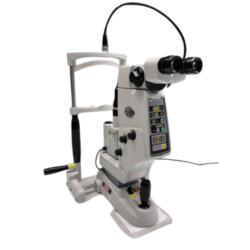The YAG Laser in Ophthalmology

How the YAG Laser has Changed Eye Care
Introduction
Laser technology has completely transformed the field of eye care, offering safe, precise, and non-invasive treatments for various conditions. Among the different types of lasers used in ophthalmology, the YAG laser is one of the most important. It helps restore vision, treat glaucoma, and eliminate floaters, making it an essential tool for eye doctors worldwide.
In this article, we’ll explore what an YAG laser is, how it’s used, and why it’s such a valuable part of modern ophthalmology.
What is a YAG Laser?
An Nd:YAG laser is a special type of medical laser that uses light energy to safely and precisely treat various eye conditions. Unlike traditional surgical tools, YAG lasers allow eye doctors to perform procedures without making any incisions, reducing risks and speeding up recovery time.
These lasers are commonly used in routine eye care and have helped millions of patients regain clear vision or prevent serious eye problems.
How Are YAG Lasers Used in Eye Treatments?
1. Treating “Secondary Cataracts” (Posterior Capsulotomy)
- After cataract surgery, some patients experience blurry vision due to a cloudy membrane behind their new lens.
- A YAG laser can quickly and painlessly remove this cloudy area, restoring clear vision in minutes.
- The procedure is simple, safe, and done in a doctor’s office with no downtime.
2. Preventing Vision Loss from Glaucoma (Peripheral Iridotomy)
- Glaucoma is a condition where pressure builds up inside the eye, potentially leading to vision loss.
- YAG lasers create a tiny opening in the eye’s iris to help fluid drain properly, preventing dangerous pressure buildup.
- This laser treatment is a quick and effective way to prevent severe glaucoma-related vision loss.
3. Removing Annoying Eye Floaters (Vitreolysis)
- Many people experience “floaters”—small, shadowy specks drifting across their vision.
- For some, these floaters become so distracting that they affect daily activities.
- YAG lasers can break up and remove floaters, allowing for clearer vision and improved quality of life.
Top YAG Lasers in the Market
ZEISS VISULAS YAG III
- Known for its gentle and precise treatment.
- Uses low-energy pulses to safely remove obstructions without damaging surrounding tissue.
- Provides fast treatment times for a smoother patient experience.
Nidek YC-1800 YAG Laser
- Designed for easy operation and high precision.
- Features an ergonomic joystick that allows doctors to make quick adjustments during treatment.
- Compact and easily transportable, making it a great option for clinics.
Ellex Ultra Q Reflex
- A highly efficient microsurgical YAG laser for delicate eye procedures.
- Designed to minimize energy use, making it one of the safest options available.
- Specially made for treating floaters with a unique optical system.
Why Choose Laser Locators for YAG Lasers?
At Laser Locators, we specialize in high-quality, refurbished ophthalmic lasers, including YAG lasers from leading brands. Every laser we sell is:
✔️ Fully refurbished and tested to meet manufacturer standards.
✔️ Backed by a 1-year warranty for peace of mind.
✔️ Carefully inspected by our expert technicians before delivery.
If you’re looking for reliable, cost-effective YAG laser solutions, we’re here to help!
